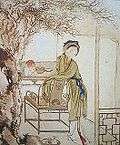Gao E (writer)
| Gao E | |||||||||||||||||||
| Traditional Chinese | 高鶚 | ||||||||||||||||||
|---|---|---|---|---|---|---|---|---|---|---|---|---|---|---|---|---|---|---|---|
| Simplified Chinese | 高鹗 | ||||||||||||||||||
| |||||||||||||||||||
Gao E (Chinese: 高鶚, c. 1738 – c. 1815) was a Chinese scholar and editor. He was a Qing dynasty scholar who attained the level of juren in 1788 and jinshi in 1795. A Han Chinese who belonged to the Bordered Yellow Banner, he became a Fellow of the Hanlin Academy in 1801. His courtesy name was Yunfu (雲甫) and art name Lanshu (蘭塾,"Orchid Study-Place")
In 1791, together with his partner Cheng Weiyuan (程伟元), he "recovered" the last forty chapters of Cao Xueqin's monumental novel Dream of the Red Chamber (sometimes called The Story of the Stone). The nature and extent of his contributions to the work and the sources of his material are a matter of controversy, but it is believed by a large number of modern orthodox Redologists that the last forty chapters were not written by Cao Xueqin.[1] He also edited the first eighty chapters together with Cheng.
In 1921, Hu Shih proposed that the last forty chapters of Dream of the Red Chamber were written by Gao E himself. His proposition was accepted by many orthodox Redologist scholars, like Zhou Ruchang. Gao and Cheng's continuation is believed by some as a conspiracy by the Qing dynasty imperial court to hide the semi-autobiographical nature of the novel, which involves the politics of the Yongzheng era.[2] During the mid-20th century, the discovery of a pre-1791 "120 chapter manuscript" complicated the questions regarding Gao's involvement.[3] Irene Eber found the discovered manuscript "seems to confirm Cheng and Gao's claim that they merely edited a complete manuscript, consisting of 120 chapters, rather than actually writing a portion of the novel."[3]
References
- ↑ See Cai Yijiang, 蔡义江:《后四十回没有曹雪芹一个字》; 周汝昌:《流行本《红楼梦》后四十回叙书》--“一百二十回是‘假全本’”。
- ↑ Conspiracy of the Red Mansions, Joel Martinsen,, December 8, 2006 http://www.danwei.org/books/conspiracy_of_the_red_mansions.php, Retrieved February 16, 2011.
- 1 2 Hasan-Rokem, Galit and David Dean Shulman (1996). Untying the knot: on riddles and other enigmatic modes. Oxford University Press. p. 237. ISBN 0-19-510856-6.
Sources
- Zhou Ruchang, 周汝昌:《流行本《红楼梦》后四十回叙书》,北京出版社, pp. 307–8.
